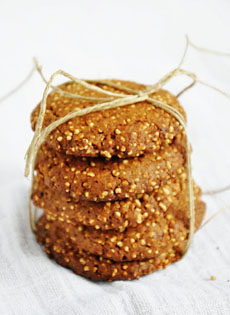TIP OF THE DAY: Amaranth, The Grain Of The Future
|
Following yesterday’s recommendation of four uncommon whole grains, we received several queries about amaranth.
Amaranth is planted worldwide, harvested for cereal and leaf vegetables, and used as ornamental plants. It has been cultivated for 8,000 years. There are some 60 species, tall plants with foliage ranging from purple and red to green or gold. Like buckwheat and quinoa, amaranth is not a grain but a pseudograin. The difference: True cereals are grasses, pseudocereals are broadleaf plants. Their overall nutrient profile is similar to that of cereals, and they are similarly utilized in cooking. The seeds of pseudograins (analogous to the grains of cereals) can be cooked whole or ground into flour, which in turn becomes cereal, goes into tortillas and other baked goods, and becomes snack food: made into candy and chips, popped and made into a bar mixed with honey, sunflower and pumpkin seeds. |
Tiny beads of amaranth, the seeds of the plant. Photo courtesy Bob’s Red Mill. |
|
|
Pseudocereals can be even more nutritious than grains: both amaranth and quinoa are whole proteins and gluten free. A whole protein contains all of the essential amino acids—like meat or milk, but actually a higher quality protein. Amaranth also contains significantly more calcium, iron, fiber, magnesium and protein than cereals like oats, rice, rye, sorghum and wheat. In fact, amaranth packs more protein than any other plant on earth; NASA selected it as part of its astronauts’ diets. The leaves Amaranth pack more calcium, iron and vitamin C and than spinach. It also can withstand the triple digit temperatures of climate change, which corn cannot. Amaranth was a staple grain of the pre-Colombian Aztec diet, along with corn (maize). But amaranth was banned by the Spanish conquistadors for its use in human sacrifice rituals. Corn went on to become a staple grain worldwide, while amaranth faded into obscurity in Mexico. It did, however, spread around the world: Both leaves and seeds became important food sources in areas of Africa, India and Nepal. In recent decades, amaranth it has spread to China, Nigeria, Russia and Thailand, and other parts of South America. And, it’s now grown in the U.S., in Iowa, Missouri, Nebraska, New York (Long Island) and North Dakota. The plant, called “the crop of the future” by Science magazine in 1977, is finally making a comeback in Mexico thanks to two American philanthropists who are encouraging farmers to grow it. Mexico has the highest rate of adult obesity in the world, yet each year some 10,000 children die from malnutrition.* |
||
 Amaranth cookies. Here’s the recipe. Photo © ChocorrolDeVainilla.com. |
COOKING AMARANTH
The flavor of amaranth flavor runs from light and nutty to lively and peppery. It’s a natural ingredient for breads, cookies, crackers, muffins, pancakes and porridge. The cooked grains can be spread sprinkled on salads and soups. Cooking amaranth is very easy. As with cereal grains, simply boil with water and salt (6 cups of water per cup of amaranth) for 15-20 minutes, stirring occasionally; then drain, rinse and eat. The cooking liquid becomes thick and viscous from the starch released as the amaranth cooks. Cooked amaranth never loses its crunch completely. Chewing a spoonful of cooked amaranth grains has been compared to eating a spoonful of caviar: a slight pop on the surface and a soft inside. |
|
|
Try these recipes: Sources:
|
||
